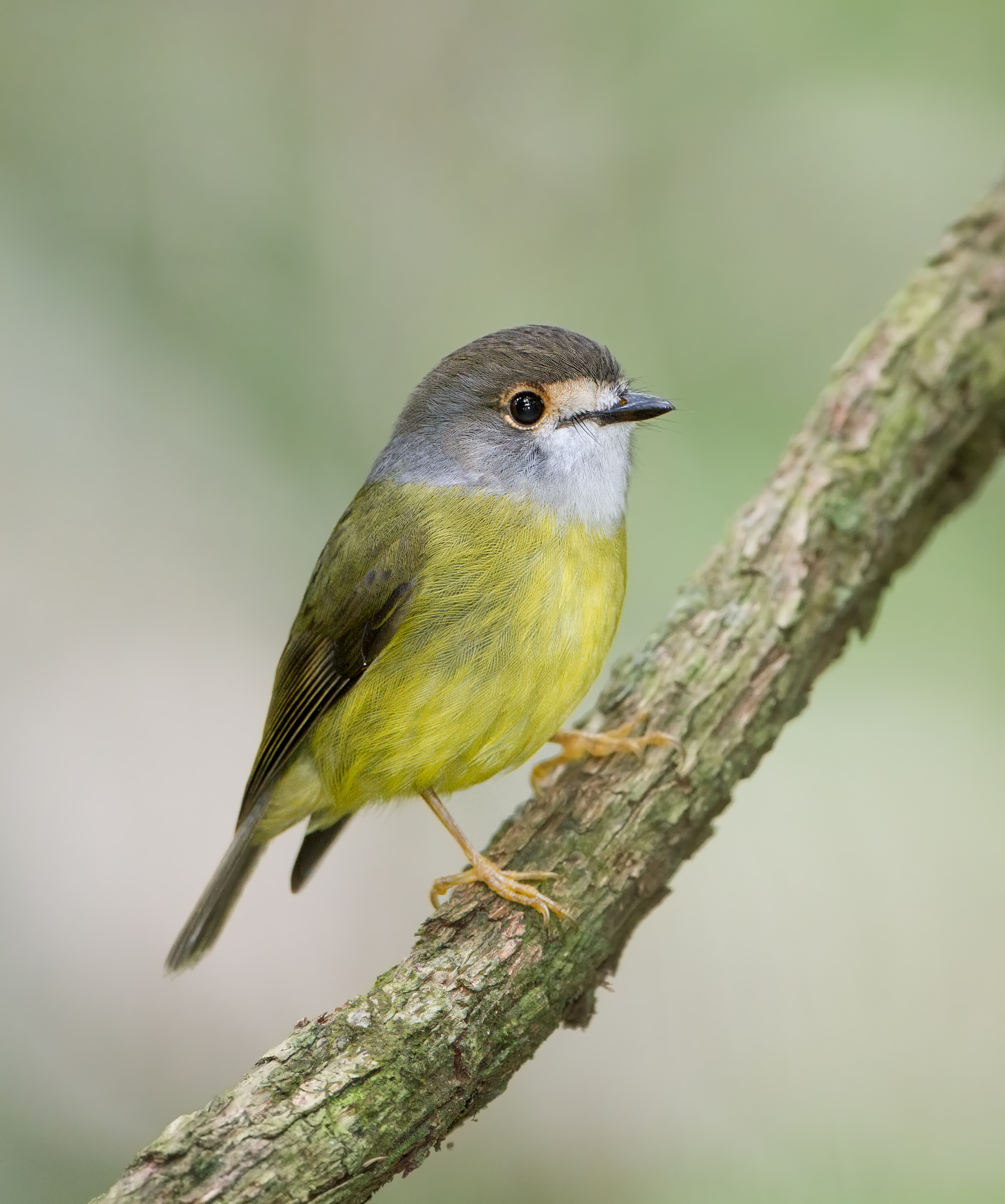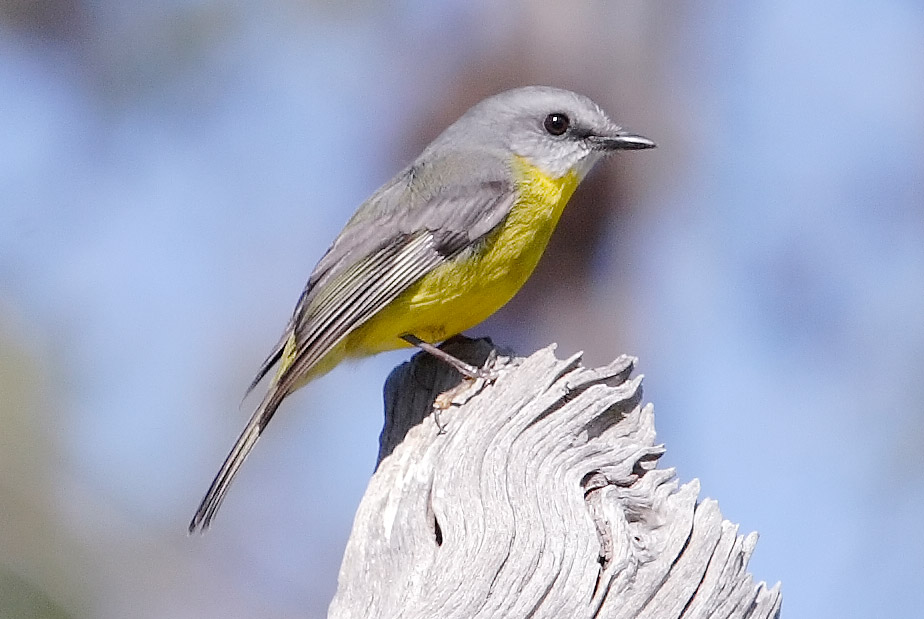|
Petroicidae
The bird family Petroicidae includes 51 species in 19 genera. All are endemic to Australasia: New Guinea, Australia, New Zealand and numerous Pacific Islands as far east as Samoa. For want of an accurate common name, the family is often called the Australasian robins. Within the family species are known variously as robins, scrub-robins and flyrobins. They are only distantly related to the European robin of Europe, north Africa and western Asia, a member of family Muscicapidae. Characteristics Most species have a compact build with a large, rounded head, a short, straight bill, and rounded wingtips. They occupy a wide range of wooded habitats, from subalpine to tropical rainforest, and mangrove swamps to semi-arid scrubland. All are primarily insectivorous, although a few supplement their diet with seeds. Hunting is mostly by perch and pounce, a favoured tactic being to cling sideways onto a treetrunk and scan the ground below without moving. Social organisation is usually cente ... [...More Info...] [...Related Items...] OR: [Wikipedia] [Google] [Baidu] |
Quoyornis
The white-breasted robin (''Eopsaltria georgiana'') is a passerine bird in the Australasian robin family Petroicidae and the Yellow Robin genus Eopsaltria. Occasionally it is placed in the genus ''Quoyornis''. It is Endemism, endemic to Southwest Australia, southwestern Australia. Unlike many other Australian robins, it lacks bright colours in its plumage, being a predominantly greyish bird with white underparts. Like other closely related Australasian robins, it is a cooperative breeder. It is sedentary, with pairs or small groups maintaining territories. Taxonomy The white-breasted robin was first described by the France, French natural history, naturalists Jean René Constant Quoy and Joseph Paul Gaimard in 1830 as ''Muscicapa georgiana'', taking its name from the site King George Sound, where the authors had collected specimens. It was later described by John Gould in 1846 as ''Eopsaltria leucogaster'', though as the former took precedence, its specific name remains ''georgiana ... [...More Info...] [...Related Items...] OR: [Wikipedia] [Google] [Baidu] |
Tregellasia
''Tregellasia'' is a genus of birds in the family Petroicidae that are found in Australia and New Guinea. The genus was introduced by the Australian ornithologist Gregory Mathews in 1912 with the pale-yellow robin (''Tregellasia capito'') as the type species In zoological nomenclature, a type species (''species typica'') is the species name with which the name of a genus or subgenus is considered to be permanently taxonomically associated, i.e., the species that contains the biological type specime .... The genus name was chosen to honour the Australian field ornithologist Thomas Henry Tregellas (1864-1938). Species The genus contains the following two species: References * Del Hoyo, J.; Elliot, A. & Christie D. (editors). (2007). '' Handbook of the Birds of the World''. Volume 12: Picathartes to Tits and Chickadees. Lynx Edicions. Petroicidae Bird genera Taxonomy articles created by Polbot {{Petroicidae-stub ... [...More Info...] [...Related Items...] OR: [Wikipedia] [Google] [Baidu] |
Plesiodryas
The black-throated robin (''Plesiodryas albonotata'') is a species of passerine bird in the Australisian robin family Petroicidae. It is found on the island of New Guinea. Its natural habitat is subtropical or tropical moist montane forests at 1,150–2,750 metres above sea-level. Taxonomy The black-throated robin was described by the Italian zoologist, Tommaso Salvadori, in 1875, from a specimen collected in the Arfak Mountains on the island of New Guinea. He coined the binomial name ''Megalestes albonotatus''. It was moved to the genus '' Poecilodryas'' by the English zoologist, Richard Bowdler Sharpe, in 1879. A 2011 molecular phylogenetic study found that the black-throated robin was the most divergent member of ''Poecilodryas''. The species is now the only species placed in the resurrected genus ''Plesiodryas'' that had been introduced by the Australian ornithologist, Gregory Mathews, in 1820. Description Measuring , the black-throated robin has a grey-black face, ... [...More Info...] [...Related Items...] OR: [Wikipedia] [Google] [Baidu] |
Peneothello
''Peneothello'' is a genus of passerine birds in the Australasian robin family Petroicidae. The genus ''Peneothello'' was introduced by the Australian born ornithologist Gregory Mathews in 1920 with white-winged robin (''Peneothello sigillata'') as the type species. The name combines the Latin ''pene'' "almost" and ''othello''. Othello is the "Moorish" (i.e. black) Shakespeare character. Species The genus contains the following five species In biology, a species is the basic unit of classification and a taxonomic rank of an organism, as well as a unit of biodiversity. A species is often defined as the largest group of organisms in which any two individuals of the appropriate s ...: References External links * * Petroicidae Bird genera Taxonomy articles created by Polbot {{Petroicidae-stub ... [...More Info...] [...Related Items...] OR: [Wikipedia] [Google] [Baidu] |
Melanodryas
''Melanodryas'' is a genus of passerine birds in the Australasian robin family Petroicidae. The genus was introduced by the English ornithologist and bird artist John Gould in 1865 with the hooded robin (''Melanodryas cucullata'') as the type species. The genus name combines the Ancient Greek Ancient Greek includes the forms of the Greek language used in ancient Greece and the ancient world from around 1500 BC to 300 BC. It is often roughly divided into the following periods: Mycenaean Greek (), Dark Ages (), the Archaic p ... ''melanos'' "black" with ''dryad'' "tree-nymph". Species The genus contains two species: References External links * * Petroicidae Bird genera Taxonomy articles created by Polbot {{Petroicidae-stub ... [...More Info...] [...Related Items...] OR: [Wikipedia] [Google] [Baidu] |
Gennaeodryas
The banded yellow robin or olive-yellow robin (''Gennaeodryas placens'') is a species of bird in the Australasian robin family Petroicidae that is found in New Guinea. It is the only species in the genus ''Gennaeodryas''. Its natural habitats are subtropical or tropical moist lowland forest and subtropical or tropical moist montane forest. It is threatened by habitat loss. It has a high mortality rate due to its inability to traverse across a matrix. Taxonomy The banded yellow robin was described by the Australian zoologist, Edward Pierson Ramsay, in 1879, from a specimen collected in southeastern New Guinea. He coined the binomial name ''Eopsaltria placens''. The species was subsequently placed in the genus ''Poecilodryas''. It was moved to the resurrected genus ''Gennaeodryas'', based on the results of a molecular phylogenetic study published in 2011. The genus ''Gennaeodryas'' had been introduced by the Australian ornithologist, Gregory Mathews, in 1920. The genus name combi ... [...More Info...] [...Related Items...] OR: [Wikipedia] [Google] [Baidu] |
Eopsaltria
''Eopsaltria'' is a genus of small forest passerines known in Australia as the yellow robins. They belong to the Australasian robin family Petroicidae. The name is derived from the Ancient Greek for "dawn singer/song" because of their dawn chorus. They are inquisitive and bold birds, and have been reported perching on the shoulders or boots of people in the bush. Open eucalyptus woodlands are their preferred habitat. The ornithologist John Gould likened the behaviour and mannerisms of the eastern and western yellow robin to those of the European robin. The name "yellow robin" itself was applied to the eastern yellow robin by the early settlers of New South Wales. Taxonomy and systematics The ornithologist William John Swainson named the genus ''Eopsaltria'' in 1832, placing into it the bird that was then known as the yellow-breasted thrush (''Pachycephala australis''). Two species are currently classified within the genus: the eastern and western yellow robins, which have been ... [...More Info...] [...Related Items...] OR: [Wikipedia] [Google] [Baidu] |
Scarlet Robin
The scarlet robin (''Petroica boodang'') is a common red-breasted Australasian robin in the passerine bird genus ''Petroica''. The species is found on continental Australia and its offshore islands, including Tasmania. The species was originally split in 1999 by Schodde and Mason, and as the original collection by Gmelin was from Norfolk Island, this retained the name of ''multicolor'', and is now known as the Norfolk robin. Taxonomy There are three recognised subspecies of ''Petroica boodang'': the nominate subspecies ''P.b.boodang'' is found in mainland southeastern Australia; ''P.b.leggii'' is found in Tasmania and Flinders Island in the Bass Strait; and ''P.b.campbelli'' occurs in southwestern Western Australia. Description Like the rest of the Australasian robins, the scarlet robins are stocky passerines with large heads. They range in size from 12 to 13.5 cm in length and weigh between 12 and 14 g. The plumage is sexually dimorphic. The males have black heads, ... [...More Info...] [...Related Items...] OR: [Wikipedia] [Google] [Baidu] |
Poecilodryas
''Poecilodryas'' is a genus of passerine birds in the Australasian robin family Petroicidae. The genus was erected by the English ornithologist and bird artist John Gould in 1865. The type species was subsequently designated as the buff-sided robin (''Poecilodryas cerviniventris''). The genus name combines the Ancient Greek ''poikilos'' "variegated" with ''dryad'' "tree-nymph". Species The genus contains four species In biology, a species is the basic unit of classification and a taxonomic rank of an organism, as well as a unit of biodiversity. A species is often defined as the largest group of organisms in which any two individuals of the appropriate s ...: Formerly, some authorities also placed the following species (or subspecies) in the genus ''Poecilodryas'': * Brown-backed whistler (now ''Pachycephala modesta'' in the family Pachycephalidae) * Golden monarch (nitidus) (now ''Carterornis nitida'' in the family Monarchidae) * Black-throated robin (now ''Plesio ... [...More Info...] [...Related Items...] OR: [Wikipedia] [Google] [Baidu] |
Heteromyias
''Heteromyias'' is a genus of passerine birds in the Australasian robin family Petroicidae. The genus was introduced by the English zoologist Richard Bowdler Sharpe in 1879 with the grey-headed robin (''Heteromyias cinereifrons'') as the type species. The name of the genus combines the Ancient Greek "different" and the Modern Latin New Latin (also called Neo-Latin or Modern Latin) is the revival of Literary Latin used in original, scholarly, and scientific works since about 1500. Modern scholarly and technical nomenclature, such as in zoological and botanical taxonomy a ... "flycatcher". Species The genus contains three species: References External links * * Taxonomy articles created by Polbot {{passerine-stub ... [...More Info...] [...Related Items...] OR: [Wikipedia] [Google] [Baidu] |
European Robin
The European robin (''Erithacus rubecula''), known simply as the robin or robin redbreast in Great Britain & Ireland, is a small insectivorous passerine bird that belongs to the chat subfamily of the Old World flycatcher family. About in length, the male and female are similar in colouration, with an orange breast and face lined with grey, brown upper-parts and a whitish belly. It is found across Europe, east to Western Siberia and south to North Africa; it is sedentary in most of its range except the far north. The term ''robin'' is also applied to some birds in other families with red or orange breasts. These include the American robin (''Turdus migratorius''), a thrush, and the Australasian robins of the family Petroicidae, the relationships of which are unclear. Taxonomy, etymology and systematics The European robin was described by Carl Linnaeus in 1758 in the 10th edition of his ''Systema Naturae'' under the binomial name ''Motacilla rubecula''. Its specific epith ... [...More Info...] [...Related Items...] OR: [Wikipedia] [Google] [Baidu] |
Passerides
A songbird is a bird belonging to the suborder Passeri of the perching birds (Passeriformes). Another name that is sometimes seen as the scientific or vernacular name is Oscines, from Latin ''oscen'', "songbird". The Passeriformes contains 5000 or so speciesEdwards, Scott V. and John Harshman. 2013. Passeriformes. Perching Birds, Passerine Birds. Version 06 February 2013 (under construction). http://tolweb.org/Passeriformes/15868/2013.02.06 in The Tree of Life Web Project, http://tolweb.org/ ccessed 2017/12/11 found all over the world, in which the vocal organ typically is developed in such a way as to produce a diverse and elaborate bird song. Songbirds form one of the two major lineages of extant perching birds (~4000 species), the other being the Tyranni (~1000 species), which are most diverse in the Neotropics and absent from many parts of the world. The Tyranni have a simpler syrinx musculature, and while their vocalizations are often just as complex and striking as those ... [...More Info...] [...Related Items...] OR: [Wikipedia] [Google] [Baidu] |


.jpg)





